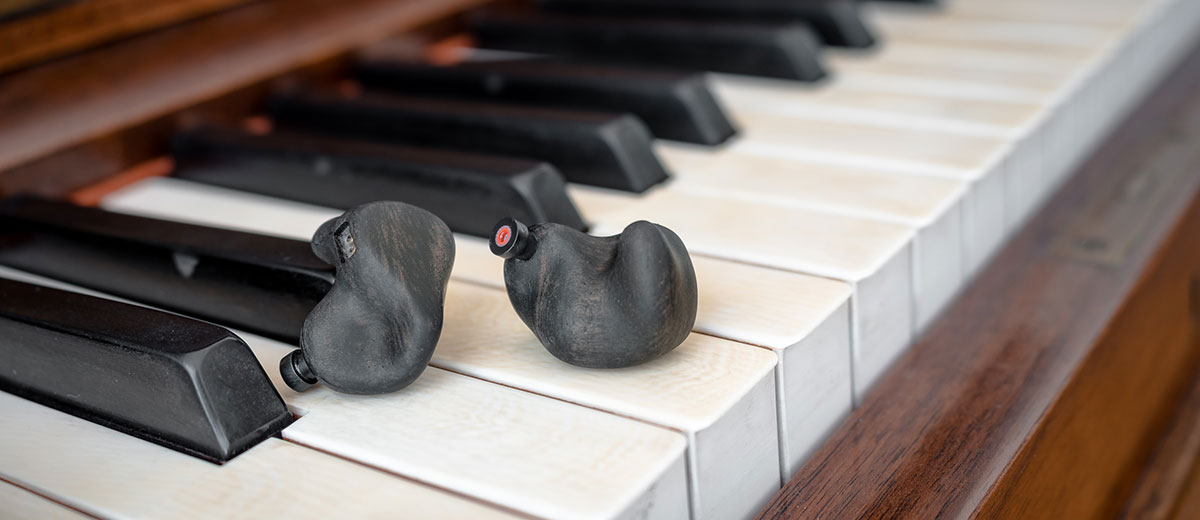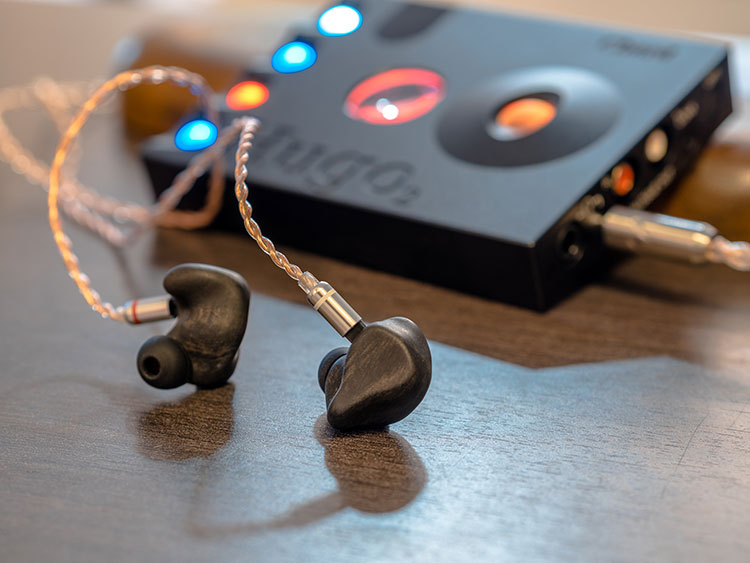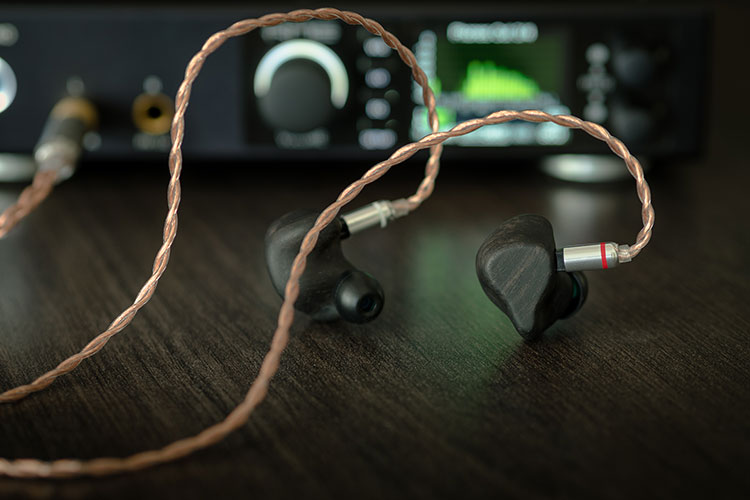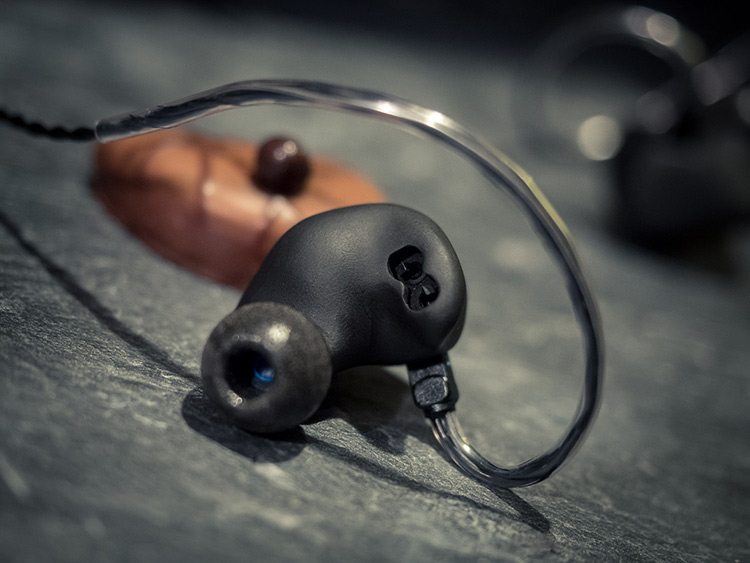Sound Impressions
Tuning
The InEar StageDiver 5 has a warm W-signature, a tuning that is basically a V-shape but with a better-compensated midrange. The SD-5 has strong bass and balanced highs but the midrange hardly sounds recessed. The tonality is slightly warm, but depending on the recording it might not be perceived as such.
Overall this is a very dynamic tuning that doesn’t even sound that colored. I do not have perfect hearing (statistically only 1 in 10.000 people have), so for reviews, I usually make sure that my ears have not been irritated for a while and that my blood pressure is low.
In this case, I perceive the SD-5 as warm and bassy, but as soon as I step out the door and find myself in a busy environment, the tonality quickly turns over to fully balanced. Add some adrenaline and I wouldn’t mind even more warmth. What’s more, after using the StageDiver 5 for two weeks as my main IEM, I did not find the bass to be strong at all anymore. My mind had adjusted so well, that I had problems re-adjusting to a neutral signature.
Bass
The bass curve is homogenous and sounds very natural with no particular accentuation on sub-bass or upper bass. The distribution is reminiscent of other popular tunings like the Campfire Andromeda or Vision Ears VE8 but might even peak 2 dB higher in the very lows.
I am by no means a bass head, but my mind adjusted quickly to the bass. It’s a voluptuous presentation that feels organic but at the same time also not falsely detailed. The BA receivers manage to create a big body but they won’t fool you into thinking they were a dynamic driver. My guess is that InEar uses vented BAs for the lows which is a popular choice for a nice balance of impact and precision.
Mids
The midrange has a slightly warm touch in the lower regions from minimal bleeding of the bass. This gives a little more authority to male vocals and makes them sound more intimate. The high mids are lowered just slightly below the recommended pressure of targets suggested by Harman, for example, but this is definitely a more musical interpretation that causes less fatigue.
Less enjoyable information like crunchy or edgy guitars is smoothed out and receives a more lush and juicy signature. I am surprised how InEar managed to make female voices sound almost perfect. They are detailed but not harsh and the timbre is spot-on without the dry presentation of a neutral reference.
Highs
The high frequencies are boosted with a single broad bump at 7-8 kHz. Luckily, the SD-5 does not show the usual ups and downs that even many TOTL IEMs show in the highs, which creates a very realistic tonality. The midrange and highs are contrasted with just a minor dip which helps ‘S-tones’ to remain wonderfully smooth.
The SD-5 does not have issues with sibilance but the slight treble forwardness can cause fatigue with extended listening. Otherwise, cymbal shimmer and detail are all there and rival even the company’s own flagship.
Soundstage
The StageDiver 5 portrays a very engaging and spherical soundstage that is good in width and depth. Compared to wider and more distanced presentations of the SD-2 and PP8, the SD-5 has a more defined depth dimension that can be intimate but also well-distanced in the midrange at the same time.
The SD-5 scales wonderfully to the recording in this regard. The bass is not as forward as many other IEMs with warm signatures even though it can hit very deep. The balanced treble helps to create enough distance and increases the overall size.
Resolution
The resolution of the midrange and treble is superb. The SD-5 really does not have to shy away from many reference TOTL flagships and it is impressive that InEar managed to do so even with “only” 5 drivers.
Great clarity makes instrument separation and multiple layers in the soundstage sound almost too easy. At the same time, the bass manages to give physical impact while giving just enough texture before sounding dry. There is really not much space left for improvement.
Matchability
Effects of output impedance
The InEar StageDiver 5 are not as picky with the source as many other multi-BA IEMs. With amps that have a higher output impedance of around 3 ohms and up, the sound becomes a little honkier and the midrange slightly duller. The effect isn’t strong enough to “break” the sound signature or make the SD-5 unlistenable. However, these do sound best from a source that does not largely exceed 3Ω OI. If you want to make sure you stay within that area, the ifi IEMatch is a good recommendation.
Sensitivity to hiss
The StageDiver 5 lets you pick up hiss from a source but they aren’t particularly sensitive in this regard. They’re in-between the ProPhile 8 and qdc Gemini, meaning I can hear the hiss from something like the Nintendo Switch clearly, but not to the point where I would consider it a big issue. For the full potential, you are best advised to consider a DAP or amp with a really black background.
Chord Hugo 2
I’m really sorry for the recurrence of the same sources in my reviews. But alas, I have not found any reason to change my private audio setup in regards to sources. So here we are again, pairing IEMs with the Hugo 2. But this time, it’s black and sounds much darker with deeper bass – just kidding! It still sounds the same, but that’s a good thing.
The background noise is very low and just barely noticeable in the most silent surroundings. The WTA filters create an equally fluid and detailed presentation of the source material. Compared to the iPhone with headphone adapter dongle, the bass is noticeably tighter and the treble softer. Of course, the Hugo 2 is more than overkill but it helps to create an expectation from higher quality sources.
RME ADI-2 DAC and Pro
I should not have to tell you what the RME devices sound like because you should already be using them yourself! This is a stealth device with no coloration at all and superb dynamics with noise as low as it gets. The Pro version of the ADI-2 does not have a dedicated IEM output but even without, I cannot hear any noise. The StageDiver 5 is not the most demanding of all IEMs, but improvements are audible even if subtle.
Selected Comparisons
The StageDiver series
StageDiver 2
The StageDiver 2 are probably still the company’s best selling monitors. It is very difficult to find a flaw with them and even five years after release they hold up well with the competition. Two BA receivers deliver a fairly neutral sound with a slightly warm roll-off above 2 kHz. It makes it easy to listen to all kinds of recordings and the soundstage’s width was one of the features that drew a lot of attention in the hifi market.
Fans of the SD-2 are probably best advised to upgrade to the PP8 as the SD-5 has quite a different presentation. Whereas the SD-2 are relaxed, the SD-5 jump into the action. Voices are more intimate, the bass is far more thunderous and the treble is also more forward. There’s really more of everything.
The soundstage of the SD-5 is equal in width but deeper and more intimate at the same time. Instruments sound better rendered but depending on your preference, the SD-5 might not be a clear upgrade unless you need more excitement.
StageDiver 3
The SD-3 are more of a musician’s tool and I think they are best suited for bass players and drummers. Technically, they are a close relative of the SD-2 with an additional bass driver to evenly boost the low-end. As a result, the SD-3 sounds very warm and the bass bleeds into the midrange for a dark and thick presentation.
While “SD-2 with more bass” sounds great on paper, the SD-3 doesn’t deliver on that for hifi consumers. The SD-5 are a much better attempt in this regard. Actually, the SD-5 has even more bass than the SD-3 but it’s better distributed toward the sub-bass whereas the SD-3’s is most prominent in the upper region.
The midrange has better tonality thanks to the boosted treble and the SD-3 sounds dull and incomplete in comparison. Imaging works far better on the SD-5 while the soundstage is comparable in overall size.
StageDiver 4, feat. Campfire Andromeda
The SD-4 are InEar’s attempt at a hifi v-shape. I think these flew under the radar and could have been a bigger success because the tonality is actually very similar to the later released Campfire Andromeda up to 3 kHz with just a bit more lower treble leading up to a comparable peak at 7-8 kHz.
If you take a source (or cable) with higher impedance, the Andromeda will boost the midrange from 2 kHz and up, effectively closing in on the SD-5. The downside is that at 3 ohms and up the treble of Andromeda becomes very sibilant. I consider the SD-5 as more refined as they have the better midrange of a tweaked Andromeda but do not exaggerate in the highs.
Compared to the SD-4, the StageDiver 5 adds a whole other dimension to the midrange, packed with information and small cues like lip movement and better separation that both other IEMs lack. The treble of the Andro is darker which might be of preference for some.
Overall, I actually think that the SD-5 are an improvement of the usual V-shaped signatures as is the case of the SD-4 because the W-shape proves to be much more versatile, more accurate, and still manages to sound as dynamic.
InEar ProPhile 8
Looking back at my detailed review from February 2017, there isn’t anything I want to change about the description of the ProPhile 8.
The PP8 has one of the best interpretations of studio-neutral sound yet. There is but a hint added low-end and a minimal cut in the vocal presence. This is – from what I’ve heard – the best attempt at delivering neutral sound via IEM and still making it sound as enjoyable as near-field monitors. I can use these for hours and hours and I don’t find them fatiguing at all. The treble I perceive is flat like no other IEM I know, which allows insane detail and transparency.
There are two shortcomings, though. One, I think the bass isn’t as tight as it could be. And second, the treble extension is only ok. By now there are multiple IEMs with BA drivers that have far better extension in the highs. However, that is not where the important information of the music is, so I think it is better to focus on tonality first and treble extension second.
Tonality
Switching to the StageDiver 5, I am surprised how comparable voices actually sound. They might be a bit warmer on the SD-5, but not that much. The SD-5 are a bit louder at the same volume setting.
Bass and highs are well-balanced and boosted in almost equal terms. The SD-5 packs quite a punch in the bass. It’s surprisingly fun and gives the music a much more lively feeling. However, looking at the market, saying the SD-5 is warm and bassy does not sit well. Other popular IEMs are much warmer and feature much more rumble.
The treble here is a very good counterweight and manages to push the bass back a bit. Luckily, the treble is very smooth, but nonetheless, it is boosted and thus it is quite a bit more fatiguing than the PP8 over extended sessions. On the plus side, this also helps with treble extension and the SD-5 reaches a bit further than the PP8. There is a small dip at 5-6 kHz which eliminates most of the sibilance on poorly mastered tracks, but with few recordings, trumpets can be a bit too hot for my taste.
Of course, any kind of coloration will create drawbacks, but they are kept at a minimum here. I’d even go as far to say that if neutral tonality is not your priority, the SD-5 might even be a better fit than the PP8. The bass is tighter and the presentation overall more colorful and fun. Plus, since the frequency response only has two prominent bumps, it is super easy to use an equalizer to transform the SD-5 into a reference monitor similar to the PP8.
ProPhile 8 with activated bass and treble boost
Going back to the ProPhile 8 with both switches. The PP8 w/ +3 bass and +2 treble is a good approximation of the SD-5. But it’s only halfway there. The PP8 (on/on) still has more forward mids and overall sounds a bit brighter than SD-5. The bass focus is deeper and thus has more distance to the listener. The bass of SD-5 is crunchier and somehow has the better attack. Some say my preference for neutral sound is hardcore, but I myself am shocked at how easily I can get lost with the SD-5.
Comparison Verdict
Technically, I can even see some advantages of the StageDiver 5 over the ProPhile 8, like tighter bass and better treble extension. Micro details are easier to find and the music just sounds fuller and more dynamic at the same time.
InEar actually describes the SD-5 as “neutral” in their product description and I can see that many will agree as bass, mids and treble are overall fairly balanced. Personally, I think this adjective is better suited for the ProPhile 8, which InEar says is tuned “for professional mixing and mastering”.
The PP8’s strength shows after prolonged use. It may seem like a dish that wasn’t seasoned at first, but once your ears have become more perceptive, the PP8 will allow you to focus better on the overall recording. I shall allow the comparison of a raw photo (PP8) and the final edit (SD-5).
Our Verdict
The InEar StageDiver 5 are technically easily the best of the series. In fact, I think the SD-5’s strengths even outperform the company’s reference flagship ProPhile 8 if linearity is not a top priority.
The tonality is extremely engaging and balanced at the same time and I can see some less experienced users thinking they are neutral. I have become a big fan of the midrange and I am surprised how easily my mind adapts to the signature.
But not only the sonic performance impresses. The StageDiver is still the most comfortable universal IEM series for my (German male) ears. The design allows a tight and deep fit and I don’t know anything that comes closer to an actual CIEM. For the first time, a small version is already available with the product launch.
Those striving for high-end audio can achieve further improvement by upgrading the cable and they also have the option of choosing real wood designs and an optional leather case to match the performance. Do not let the driver count fool you, this is a TOTL monitor!
StageDiver 5 Technical Specifications
- System: 3-way system(5 drivers)
- Transmission range: approx. 20 Hz–20000 Hz
- Output sound pressure: 120dB
- Impedance: 13 Ohms
- Cable length:140 cm / (4’7.5″)






